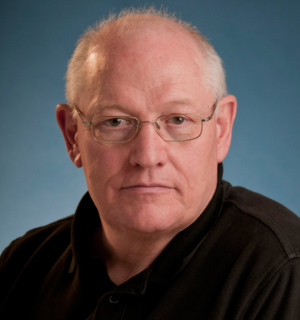
Dr. Hans Messner, a pioneer of allogeneic bone marrow and stem cell transplantation in Canada, will retire this December after 44 years at Princess Margaret Cancer Centre. (Photo: UHN Photographics)
Hans Messner means many things to many people. Here are a few examples:
"He saved my life."
- Margaret Lynch, patient and Director, Internet and Social Media,
The Princess Margaret Cancer Foundation
"His energy, dedication and leadership were crucial to the success of the clinical marrow transplant program he initiated."
- Dr. James Till, Senior Scientist at Princess Margaret Cancer Centre, best known for his
joint discovery of stem cells with the late Dr. Ernest McCulloch
"His wife was in labour and he was reluctant to leave a sick patient. We had to physically remove him from the hospital, put him in a taxi, and promise to stay all night with his patient,
which we did!"
- Dr. Mary Gospodarowicz, Medical Director, Princess Margaret Cancer Centre
"In the 30 years I've known him, he's always been able to take the impossible
and make it possible."
- Janice Stewart, Director of Operations and Regional Planning, Odette Cancer Program Sunnybrook Health Science Centre and former Clinical Director Oncology, UHN
"He gave me a second chance at life, an opportunity to give back to others."
- Chris Taylor, patient
Lynch, Till, Gospodarowicz, Stewart and Taylor have at least one thing in common: they've been inspired by the passionate and courageous Dr. Hans Messner, a pioneer of allogeneic bone marrow and stem cell transplantation in Canada.
The early years
When Dr. Hans Messner, Staff Physician in the Department of Medical Oncology at the Princess Margaret Cancer Centre, met Dr. Ernest McCulloch, one of the "Fathers of Stem Cell Science" for the first time, he didn't think he'd be mistaken for a German Secret Service Agent.
In 1966, he was asked to go to the airport to pick up McCulloch, who was invited to speak at a stem cell conference in Freiburg, Germany where Messner was attending university.
"I asked the officer to point him out because I didn't know what he looked like," said Messner. "The officer examined McCulloch's passport and signaled to me that 'this was the guy' – McCulloch later told me he thought he was going to be arrested on the spot!"
McCulloch and Messner became fast friends and colleagues. They discussed Messner's doctoral thesis. By the end of the conference, McCulloch offered Messner a life-changing opportunity. "Dr. McCulloch came to me and said, 'I've talked to your supervisor, and you are going to come to Toronto,'" recalled Messner. "I said, 'I am?' – and that's how I arrived in Toronto a few years later."
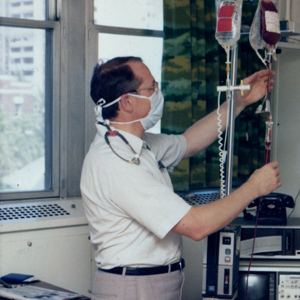
Messner performs one of the first stem cell transplants at Princess Margaret Cancer Centre,
August 1977. (Photo: Mr. Nazir Jamal)
A promising career in Canada
On May 29, 1969, Messner arrived in Toronto and walked the hallways of Princess Margaret for the first time – the same hallways that led him to the bright, blonde-haired 21-year-old graduate student he would later call his wife. The couple married in 1973 and recently celebrated their 40th anniversary.
Messner began his PhD program at the University of Toronto under McCulloch's mentorship, developing assays for human hemopoietic progenitor cells – the "mother" cells that give rise to all other blood cells.
In 1970, McCulloch began to explore the potential benefits of bone marrow transplants for the treatment of patients with leukemia. Messner was one of the team members during these early days of transplantation.
In 1976, Messner completed his first bone marrow transplant – an allogeneic transplant on a patient with chronic myeloid leukemia – the first of many.
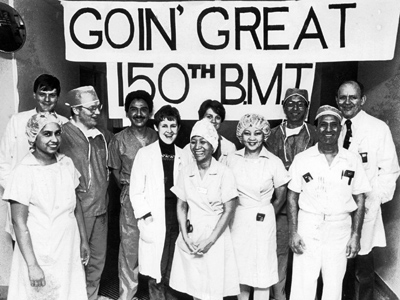
The Bone Marrow Transplant program celebrated its 150th bone marrow transplant at Princess Margaret Cancer Centre. To date, the program has performed 2,223 allogeneic transplants. (Photo: UHN Photographics)
A pioneer of bone marrow transplantation in Canada
"With Hans, commitment to patients always comes first. In the 1970s, when there was no funding to do bone marrow transplants, he just did them because that's what his patients needed," said Gospodarowicz. "His grassroots initiative has since grown into Canada's leading transplant program. This is the dedication and clarity of purpose for which Hans is rightly renowned."
"5 Center was the Bone Marrow Transplant Unit at the old PMH, and the Green team was the transplant team of which Dr Messner was the Chief. We, the nurses, dubbed it the 'Dream Team' – they were that good," said Ingrid Atyeo, Bargaining Unit President, Princess Margaret nurses, Local 97.
On July 1, 1975, Messner officially began his career at Princess Margaret. Having completed the exploratory phase, McCulloch offered him the opportunity to develop a clinical transplant program and become its first director. The offer came with one caveat. McCulloch asked him to develop a measurement tool for pluripotent human cells, which didn't exist at the time. Messner put himself to work in the lab and produced the first human assay worldwide for cells that had a pluripotent function.
"We used this in the very early stages of developing the program as a benchmark," said Messner. "We developed a number of assays for various malignant stem cell populations and generated a large number of cell lines in leukemia, lymphoma, and myeloma – they were used worldwide as a tool to investigate these diseases."
To date, the Bone Marrow Transplant program has performed 2,223 allogeneic transplants. The program has also increased the age for transplant to 70 from 40.
Messner held the position of director of the Bone Marrow Transplant Centre until 2006.
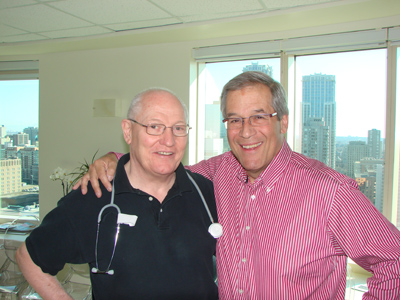
Hans Messner stands with patient, Chris Taylor, who calls Messner a “doctor, researcher, teacher, mentor, medical imagineer and friend.” (Photo: Chris Taylor)
An inspiration to patients
"Hans Messner is many things to me. I was introduced to him first as a patient dying of blood cancer. From our first handshake, his truthfulness, knowledge, critical thinking, and patient-communication skills, provide the foundation for my respect of this great physician, one of the founding fathers of stem cell transplantation," said Taylor. "He is my doctor, a researcher, a teacher, mentor, medical imagineer, and a friend to me, and my family."
In 1981, Messner became the Founding President of the Canadian Bone Marrow Transplant Group (CBMTG). This organization has developed into the Canadian intellectual home for individuals with interests in stem cell transplant related clinical and research activities. CBMTG established the Hans Messner lecture held during the annual meeting.
In 1995, Messner was asked to serve on the expert working group, developing the Canadian Standard for Transplantation of Cells, Tissues and Organs.
In 2004, the Philip S. Orsino Cell Therapy facility was established at Princess Margaret. Orsino was a patient at the cancer centre requiring an allogeneic transplant. Unfortunately, he didn't have a compatible donor and had to go to the United States to have the transplant done – it was successful. Orsino thought it would be useful for Princess Margaret to develop a more sophisticated lab where cases like his could be considered.
Messner served as the medical director, developing the whole structure, including: regulatory systems, supervising the construction of the facility and directing early clinical phases.
In 2007, Messner received the Canadian Blood Services Lifetime Achievement Award for being a pioneer of allogeneic bone marrow and stem cell transplantation in Canada.
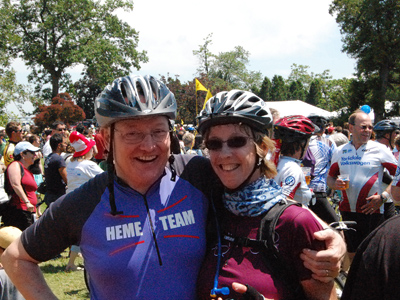
Hans Messner stands with Margaret Lynch, teammate in the ‘Ride to Conquer Cancer’ in 2008. Lynch, a colleague and patient of Messner’s, said, “He’s an ‘inspiration – he treats us like people, not diseases.” (Photo: Margaret Lynch)
Messner, a competitive rider
Messner, an avid biker, has been riding in the Enbridge Ride to Conquer Cancer benefiting the Princess Margaret since its inception in 2008.
"My favourite memory of Dr. Messner comes from the initial Ride to Conquer Cancer. Hans and I met up on a country road somewhere between Toronto and Hamilton. We chatted for a few minutes and then I figured I'd just pull out and pass him since I'm several decades younger than him," said Bob Bell, President and CEO, UHN. "But Hans kept pace kilometer after kilometer and finally pulled out and left me in his dust. Underestimating Dr. Messner's commitment to the task at hand is a mistake!"
For Messner, the ride is about giving patients hope.
"The ride is a motivation for patients to appreciate that there is life after cancer," said Messner, "you just have to find it."
Life beyond Princess Margaret
While Messner will continue to serve on several academic advisory boards in three German institutions, he's looking forward to spending time with family – his wife, four children and four grandchildren – and of course, having more time to ride. He hopes to one day ride L'Alpe d'Huez, the most iconic climb in the Tour de France.
"I've been with this institution for 44 years, so I consider it my career home," said Messner. "The biggest change will be not having the direct patient contact I've always enjoyed the most, and the relationships I've built with my colleagues and friends, who have made this an incredible journey."
